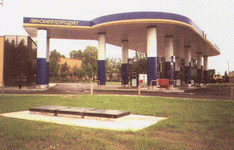Separator liquid petrolleum hydrocarbon
Purpose
Separators liquid petroleum hydrocarbon (ORL) serve for the separation of free petroleum and gasoline products that are washed off from parking and lay-out areas and the like. Coalescence is the basic physical process applied in the separator. This process can be completed with a sorption effect.
Process
Separation of petroleum products uses a principle of double-stage separation.Lighter petroleum products float over water surface and heavier particles settle down in a settling zone. Then pre-treated water flows through a coalescent filter and through a sorption filter, if need be, for final purification. Water flows through an inlet piping in a settling zone where a downflow baffle is installed. In this settling zone floating and settleable particles are separated with respect to their different density. Then pre-treated water flows over a partition to the other zone.
The other zone is provided with coalescent filters. When water flows through coalescent filter petroleum particles coagulate in clusters and float up to water surface from where they are skimmed off. If a sorption filter is fitted then floated and dispersed petroleum products are separated more efficiently. Sorption substances are put in polypropylene baskets that are attached to supporting frame of liquid petroleum hydrocarbon separator.
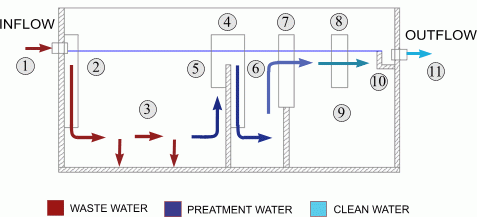
Schema of separator ORL
|
Legend:
1. Inflow, 2. Downflow baffle (baffling), 3. Settling zone, 4. Overflow crest, 5. Scumboard (to trap floating impurities), 6. Baffle wall (baffling), 7. Coalescent filter I, 8. Coalescent filter II, 9. Coalescent zone, 10. Effluent weir, 11. Outflow
Design Description
Liquid petroleum hydrocarbon separators are plastic tanks with inner equipment – coalescent and, if need be, sorption filter. Plastic liquid petroleum hydrocarbon separator is a complete packed container of expended polypropylene of a self-supporting design. It is positioned on a reinforced-concrete slab. Polypropylene tank is divided into two zones separated with a baffle wall. The top of the baffle wall is provided with an overflow. Several baffle walls and scumboards are installed inside the tank. The liquid petroleum hydrocarbon separator is designed with respect to valid hydrodynamic calculation and requirements for gravity separation of floating petroleum products including the effect of coalescent/sorption filtering.
Entering wastewater is stilled down and then flows through a downflow baffle to a settling zone and through a coalescent filter, floating petroleum products are entrapped on water surface and are manually scummed off. If a separator is provided with a sorption filter then wastewater passes through this filter and the filter entraps even the smallest petroleum drops.
Entrapped petroleum products are collected and have to be disposed of in special-purpose plants – incinerating plants, etc. If a sorption filter is installed it has to be replaced after its saturation with petroleum products. Special-purpose plants dispose of saturated sorption filters.
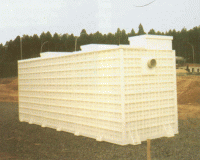
Separator ORL
|
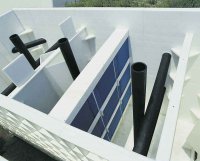
Separator ORL
|
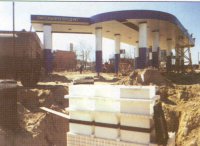
Separator ORL
|
Structural Drawing
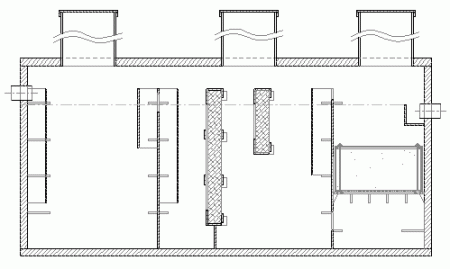
Structural drawing ORL
|
Basic Specifications
| Type | Max. flow | Area | Dimensions [m], DN [mm] | ||||||
| l/s | m2 | Lenght | Width | Height | In. | Out. | DN | ||
|
ORL with coalescent filter |
NEL to outflow under 5 mg/l |
||||||||
| ORL 2 | 2 | 170 | 2 | 1 | 2,02 | 1,7 | 1,5 | 100 | |
| ORL 3 | 3 | 250 | 3 | 1 | 2,02 | 1,7 | 1,6 | 150 | |
| ORL 6 | 6 | 500 | 3 | 1,66 | 2,08 | 1,7 | 1,6 | 150 | |
| ORL 10 | 10 | 830 | 4 | 1,66 | 2,08 | 1,85 | 1,65 | 200 | |
| ORL 15 | 15 | 1250 | 4 | 2,16 | 2,3 | 1,95 | 1,85 | 250 | |
| ORL 20 | 20 | 1700 | 5 | 2,16 | 2,3 | 1,95 | 1,85 | 250 | |
| ORL 30 | 30 | 2500 | 6 | 2,16 | 2,3 | 1,95 | 1,85 | 250 | |
|
ORL with coal. and sorption filters |
NEL to outflow 0,5 mg/l | ||||||||
| ORL 2-S | 2 | 170 | 3 | 1 | 2,02 | 1,7 | 1,5 | 100 | |
| ORL 3-S | 3 | 250 | 4 | 1 | 2,02 | 1,7 | 1,5 | 150 | |
| ORL 6-S | 6 | 500 | 4,5 | 1,66 | 2,08 | 1,7 | 1,5 | 150 | |
| ORL 10-S | 10 | 830 | 6 | 1,66 | 2,08 | 1,85 | 1,65 | 200 | |
| ORL 15-S | 15 | 1250 | 6 | 2,16 | 2,3 | 1,95 | 1,75 | 250 | |
| ORL 20-S | 20 | 1700 | 7,5 | 2,16 | 2,3 | 1,95 | 1,75 | 250 | |
| ORL 30-S | 30 | 2500 | 10,3 | 2,16 | 2,3 | 1,95 | 1,75 | 250 | |
Performance
Petroleum product content of wastewater passing through the separator is reduced by 85 up to 95 % with respect the separator type used. This high efficiency enables trouble-free outflow of effluent rainwater from parking areas directly to a recipient.
Layout in location
The figure shows the layout of a ADOS’s ORL unit for treatment of rain waters from parking lots.
A similar layout is applied for the ORL location from garages, petrol stations, vehicle maintenance shops and the like.
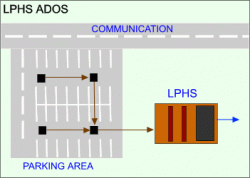
Schema ORL
|



